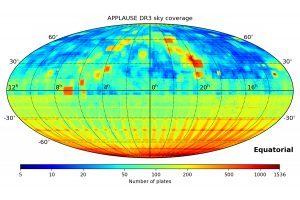New web archive with photographic plates from the Astronomical Collection at FAU now available online
If you look up at the sky on a clear night you can see stars, lots of stars. Astronomical recordings from observatories let you see them in much greater detail. The Dr. Remeis Observatory owns approximately 40,000 historical photographic plates, a genuine treasure trove for anyone interested in stargazing. Together with Leibniz-Institut für Astrophysik Potsdam and the Universities of Hamburg and Tartu (Estonia), astronomers at FAU have now digitalised roughly 70,000 such glass plates and published them online at www.plate-archive.org. The project is being funded by the German Research Foundation (DFG).

All areas of the sky have been charted in the new web database – red means that an area of sky has been recorded very often, blue are the areas that have only been recorded very rarely. Thanks to the observations of the Bamberg Observatory, the southern sky has been particularly well covered. (Image: AIP/APPLAUSE)
More than 400,000 photographic plates are stored in the archives of German observatories, accounting for approximately one quarter of all the photographic plates that exist in the whole of Europe. They are not only valuable from a historical point of view, they are still highly significant for research even today, as astronomers can use them to track the movements and changes in brightness of stars over several decades. In addition, modern digitalisation techniques and software can be used to answer a whole range of new questions, allowing astronomers to investigate millions of stars much more objectively and accurately.
However, all this potential knowledge cannot be taken advantage of unless people are actually aware that such an image exists, and know when and how it was taken. This is exactly what the APPLAUSE database delivers – together with the image itself. A sizeable catalogue of over 70,000 digitalised photographic plates from the four observatories mentioned above is now available online, covering the years 1893 to 1998. Each individual scan is several hundred megabytes in size. The largest plates that measure 30×40 centimetres can be as big as one gigabyte.
Prof. Ulrich Heber will talk about the ‘Digitalisation of the Sky’ on the 10th of January as part of the Collegium Alexandrinum, which is open to the public.
In coordination with the release, the Remeis Observatory will host a conference with the title ‘Large surveys with small telescopes: Past, Present and Future (Astroplate III)‘ in March next year. Registration for the conference is now open.
This post is a short version of the full press release of the FAU. The full article on ‘Digitalisation of the Sky’ can be found here.
Access to the APPLAUSE database: www.plate-archive.org
Conference Webpage: https://www.sternwarte.uni-erlangen.de/large-surveys-2019/
Collegium Alexandrinum: http://www.collegium-alexandrinum.de/
For more information, please contact
Ulrich Heber
Ulrich.Heber@sternwarte.uni-erlangen.de
+49 9131 85-81014




